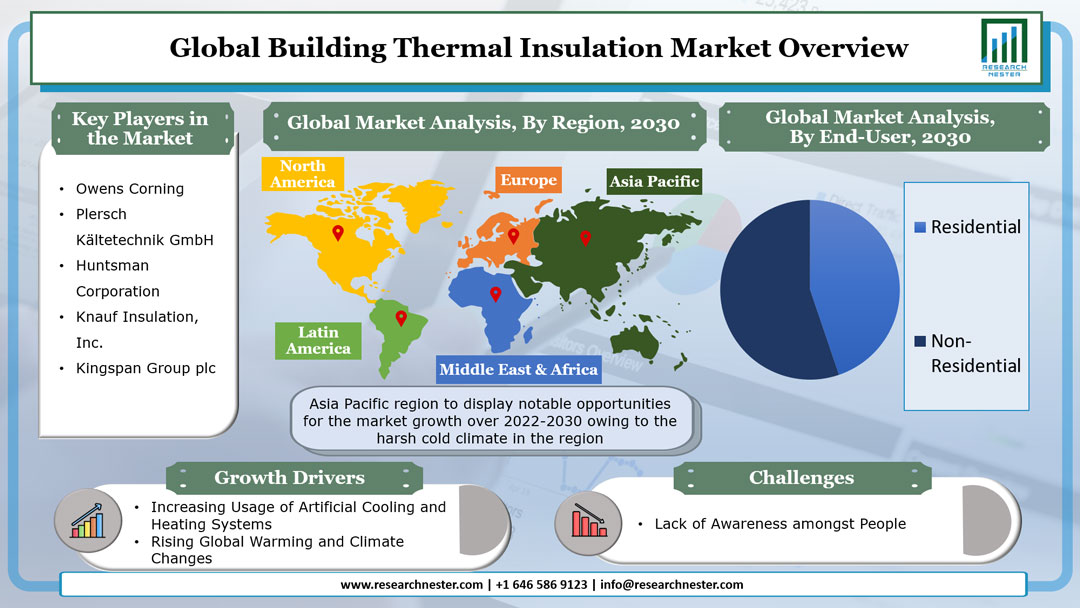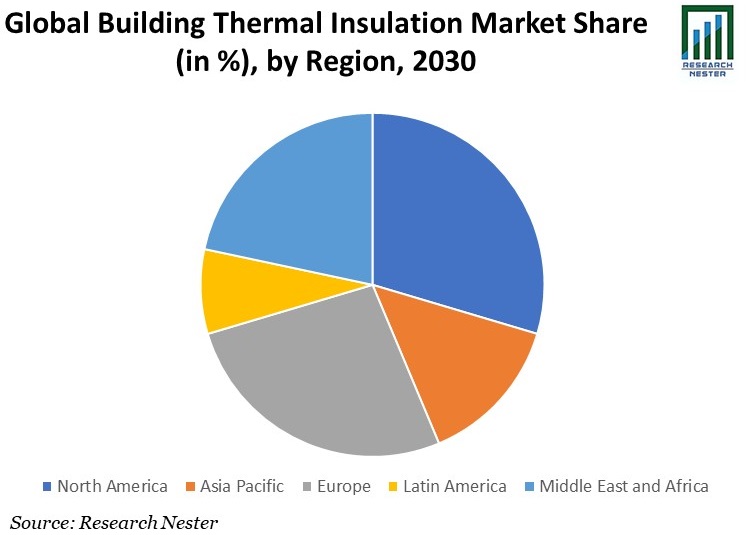Global Building Thermal Insulation Market Highlights over 2022 – 2030
The global building thermal insulation market is estimated to grow at a CAGR of ~3% over the forecast period, i.e., 2022 – 2030. The growth of the market can be attributed to the growing application of building thermal insulators to obtain better heat/cold protection. They are being immensely used in places with extreme climatic conditions, for insulating buildings where cooling or heating systems are used, as this can save cost and energy. Thermal insulators trap the heat of the building inside, and save the energy spent on space heaters. Moreover, they can also prevent the extreme cold or extreme heat waves from entering the building. The growing adoption of heating or cooling systems in buildings is estimated to boost the market growth. Furthermore, the mounting awareness regarding energy conservation is estimated to boost the market growth. the global rise in temperature and climate change, caused by various human activities, are also estimated to boost the market growth. According to a report by NASA, the global temperature is currently increasing by 0.2 degrees Celsius per decade, causing extreme rise and fall of temperature.

Get more information on this report: Download Sample PDF
The market is segmented by application into flat roof, external wall, internal wall, floor, and others, out of which, the external wall segment is anticipated to hold the notable share in the global building thermal insulation market over the forecast period on account of growing application of thermal insulation for blocking the harsh cold and heat out of the house, as external walls are the major point of entrance of the outdoor temperature. Similarly, the flat roof segment is also estimated to grow significantly throughout the forecast period.
Major Macro-Economic Indicators Impacting the Market Growth

The chemical industry is a major component of the economy. According to the U.S. Bureau of Economic Analysis, in 2020, for the U.S., the value added by chemical products as a percentage of GDP was around 1.9%. Additionally, according to the World Bank, Chemical industry in the U.S. accounted for 16.43% to manufacturing value-added in 2018. With the growing demand from end-users, the market for chemical products is expected to grow in future. According to UNEP (United Nations Environment Programme), the sales of chemicals are projected to almost double from 2017 to 2030. In the current scenario, Asia Pacific is the largest chemical producing and consuming region. China has the world’s largest chemical industry, that accounted for annual sales of approximately more than USD 1.5 trillion, or about more than one-third of global sales, in recent years. Additionally, a vast consumer base and favourable government policies have boosted investment in China’s chemical industry. Easy availability of low-cost raw material & labour as well as government subsidies and relaxed environmental norms have served as a production base for key vendors globally. On the other hand, according to the FICCI (Federation of Indian Chambers of Commerce & Industry), the chemical industry in India was valued at 163 billion in 2019 and it contributed 3.4% to the global chemical industry. It ranks 6th in global chemical production. This statistic shows the lucrative opportunity for the investment in businesses in Asia Pacific countries in the upcoming years.
Global Building Thermal Insulation Market Regional Synopsis
On the basis of geographical analysis, the global building thermal insulation market is segmented into five major regions including North America, Europe, Asia Pacific, Latin America and Middle East & Africa region. The market in Middle East and Africa region is estimated to witness modest growth over the forecast period on the back of high temperature, prevalence all the yearlong, along with growing industrial development in the region. The average temperature of this region is around 40 degrees Celsius, reaching a soaring high of 50 degrees in summers.
The market in the North America region is anticipated to gain the largest market share throughout the forecast period owing to the extremely cold climatic conditions in Canada, and some areas of the United States. Similarly, the market in Europe is estimated to grow modestly throughout the forecast period, on the back of presence of extremely cold climatic conditions in countries, such as, Russia, Norway, Denmark, Iceland, Germany, UK, and others.

Get more information on this report: Download Sample PDF
The global building thermal insulation market is further classified on the basis of region as follows:
- North America (U.S. & Canada) Market size, Y-O-Y growth & Opportunity Analysis
- Latin America (Brazil, Mexico, Argentina, Rest of Latin America) Market size, Y-O-Y growth & Opportunity Analysis
- Europe (U.K., Germany, France, Italy, Spain, Hungary, Belgium, Netherlands & Luxembourg, NORDIC, Poland, Turkey, Russia, Rest of Europe) Market size, Y-O-Y growth & Opportunity Analysis
- Asia-Pacific (China, India, Japan, South Korea, Indonesia, Malaysia, Australia, New Zealand, Rest of Asia-Pacific) Market size, Y-O-Y growth & Opportunity Analysis
- Middle East and Africa (Israel, GCC (Saudi Arabia, UAE, Bahrain, Kuwait, Qatar, Oman), North Africa, South Africa, Rest of Middle East and Africa) Market size, Y-O-Y growth & Opportunity Analysis
Market Segmentation
Our in-depth analysis of the global building thermal insulation market includes the following segments:
By Material
- Glass Wool
- Stone Wool
- Polystyrene
- Others
By Application
- Flat Roof
- External Wall
- Internal Wall
- Floor
- Others
By End-User
- Residential Buildings
- Non-Residential Buildings
Growth Drivers
- Increasing Usage of Artificial Cooling and Heating Systems
- Rising Global Warming and Climate Changes
Challenges
- Slow Adoption and Lack of Awareness amongst People
Top Featured Companies Dominating the Market
- BASF SE
- Company Overview
- Business Strategy
- Key Product Offerings
- Financial Performance
- Key Performance Indicators
- Risk Analysis
- Recent Development
- Regional Presence
- SWOT Analysis
- Owens Corning
- Plersch Kältetechnik GmbH
- Huntsman Corporation
- Knauf Insulation, Inc.
- Kingspan Group plc
- Compagnie de Saint-Gobain S.A.
- Johns Manville
- Covestro AG
- Dow Silicones Corporation

